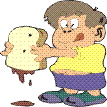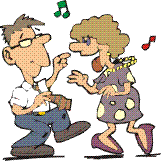to ADD
Home
About Sarah Jane
About ADHD
Coaching for ADHD
Stories
Resources
What you can do
Life Style
Maintenance
Coaching
Natural Remedies
Celebrating
6 Impossible Things To Do
Services
Contact me
Life Style for ADHD
Diet
The standard meal in Western cultures is loaded with sugar and simple carbohydrates in the form of white bread and pasta, and candy bars and sweet soda for snacks. Such food creates a surge of sugar in the blood which briefly gives a feel of energy, but a flood of insulin follows which removes the sugar from the blood and causes an energy crash leaving you feeling more tired, spacey, confused and inattentive than before. This food also lacks the proteins and vitamins your body needs to build and repair your body.
The ideal program is four or five small meals a day each containing protein and complex carbohydrates to maintain a steady supply of fuel to the brain. Proteins are found in meat, dairy products, nuts and soy products. They provide amino acids, the material to build and repair all the body systems: the immune system, muscles, hormones and especially the neurotransmitters which make the brain function. Complex carbohydrates are found in vegetables, whole grains and beans. They provide energy but take longer to digest than sugar and simple carbohydrates and therefore do not create the insulin surge that leaves you more tired than before. They also contain vitamins, minerals and fiber which your body needs for optimum health.
A word about fat- In western mythology, fat is a baddy, but, in fact, fats in the form of oils are essential for a healthy brain. By weight , the brain is more than half fat. There are different kinds of oil and all in appropriate quantities are important.
Water is essential. The brain needs a steady supply of oxygen and energy. If the blood flow slows due to dehydration , you will feel sluggish and inattentive. A glass of water will help the blood flow better.
Exercise
In a school for an Apache Indian Tribe, the program includes exercise five periods a day. If it rains they send the children home because learning is impossible without exercise. 95% of the children are hyperactive.
Until recently, experts thought that new brain cells could not be generated, that the brain cells you had at birth had to last your entire life. Research in the last ten years has shown that the brain is much more plastic. It is like a muscle; it grows when you use it. Brain cells are created, grow and link to other cells in response to usage. Exercise promotes brain growth. Use it or lose it.
The brain is a very expensive organ; It uses 50% of our food and more than 50% of the oxygen brought to the brain in the blood. Exercise increases blood flow and encourages the growth of new capillaries to increase blood carrying capacity. Exercise releases nerve growth factors called Brain Derived Neurotropic Factor (BDNF) known as Miracle-Gro, a fertilizer for the brain. BDNF enables cells to bind to other cells and makes stem cells grow. Pursuing an intellectual or physical activity stimulates the growth of new cells.
Exercise fuels the chemical factory producing neurotransmitters such as endorphins, norephineprine for arousal and alertness, dopamine for the attention system, and seratonin for mood regulation and stress control. It allows nerve cells to survive and grow. Studies have shown that exercise is as effective as Prozac in combating depression and the results last longer. Exercise also increases a recently discovered neurotransmitter, the neuropeptide of love, called phenylathalamine (PEA).
What kind of exercise suits you?
Intense aerobic exercise is best, 30 to 45 minutes at least five times a week. Once you feel the benefits you won't want to miss it the other two days. If you aren't the extreme type, a fast walk, enough to raise your heart rate will do. Dance and Tai Kwon Do or other forms of the martial arts are highly recommended for their total effect on the attention system. They take large amounts of brain power and teach respect of oneself and others and foster resilience. Yoga has also shown good results.
If you already have a well filled schedule, you can try just running in place or skipping rope for three or four minutes whenever those neurons start playing leap frog under your skin.
Breathing
Yes, breathing. Oxygen is essential for every cell in your body and especially the brain. Breathing brings oxygen in and blows off waste products like carbon dioxide. Slight changes in oxygen level can change the way you feel and behave. Under emotional stress, anger or anxiety, people change the way they breath. Breathing becomes shallow and rapid, an inefficient pattern which lowers oxygen levels.
Slow, deep breathing from the belly will help you be more focused and less anxious.
Sleep
People with ADHD often have difficulty going to sleep at night and even more difficulty getting up in the morning. Sleep deprivation makes ADD symptoms worse and can interfere with every aspect of life. There are many strategies for getting to sleep. Here are some basic rules. Avoid stimulating activities such as TV or exercise for at least two hours before bedtime. Eat a small snack which includes protein such as a glass of warm milk or cheese and crackers before going to bed. Take a warm quiet bath. Play a tape of music or sounds of nature. Experiment to find which ones work for you.
Enjoy
Perhaps you were brought up to believe that work comes before play and the two do not mix. Well, here's a new belief: doing things you enjoy and thinking enjoyable thoughts is good medicine for the brain. Try it!
 When you think positive, happy thoughts your brain produces serotonin the feel good neurotransmitter. When you think negative stormy thoughts your brain produces adrenaline, the stress hormone. Doing an activity that you enjoy acts as a stimulus for the brain.
When you think positive, happy thoughts your brain produces serotonin the feel good neurotransmitter. When you think negative stormy thoughts your brain produces adrenaline, the stress hormone. Doing an activity that you enjoy acts as a stimulus for the brain.
More To Do For ADHD